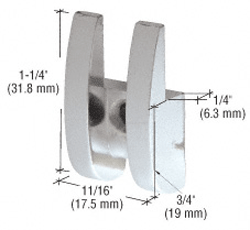

Holding a Mirror in Place with a Track or Channel Although mirror mastic can be used to keep the mirror in place on the wall, additional support from clips, track, or a rigid surface is typically necessary.

These mirrors, with the exception of ones that come with hanging brackets, are installed with mirror clips. If a mirror has curved edges – circle, oval, crescent – resting it on a track or channel is not an option. Sometimes, clips are the only viable option for mirror installation. They can be used on their own, without glue, so the mirror can be removed intact leaving only a few holes to fill. If you want a more temporary installation – because you’re renting your home, you want to remodel in a couple years, or the mirror will be repurposed later – consider mirror clips. Mirror installation is often permanent or semi-permanent because tough glue, mirror mastic, is used to stick it to the wall. (It is important for these fasteners to go into studs or be used with appropriate anchors otherwise the weight of the mirror can actually yank the fasteners out of the drywall and cause the mirror to come crashing down.) Each clip includes a void where a fastener can pass through the clip and into the wall. Mirror clips are generally made of clear plastic for an unobtrusive look that does not detract from the mirror’s clean lines. See Also: Buyers Guide: Vanity Mirror, Framed Mirrors, Antique Mirrors, and Gym Mirrors Using Clips to Hold a Mirror in Place Understanding your options and the reasons glaziers use each technique is helpful in selecting the best mirror and installation methods for your home. Both are valid methods used by glass and mirror professionals, but certain circumstances indicate the use of one over the other. Clips and track (also referred to as channel) are two common choices for mirror installation.


 0 kommentar(er)
0 kommentar(er)
